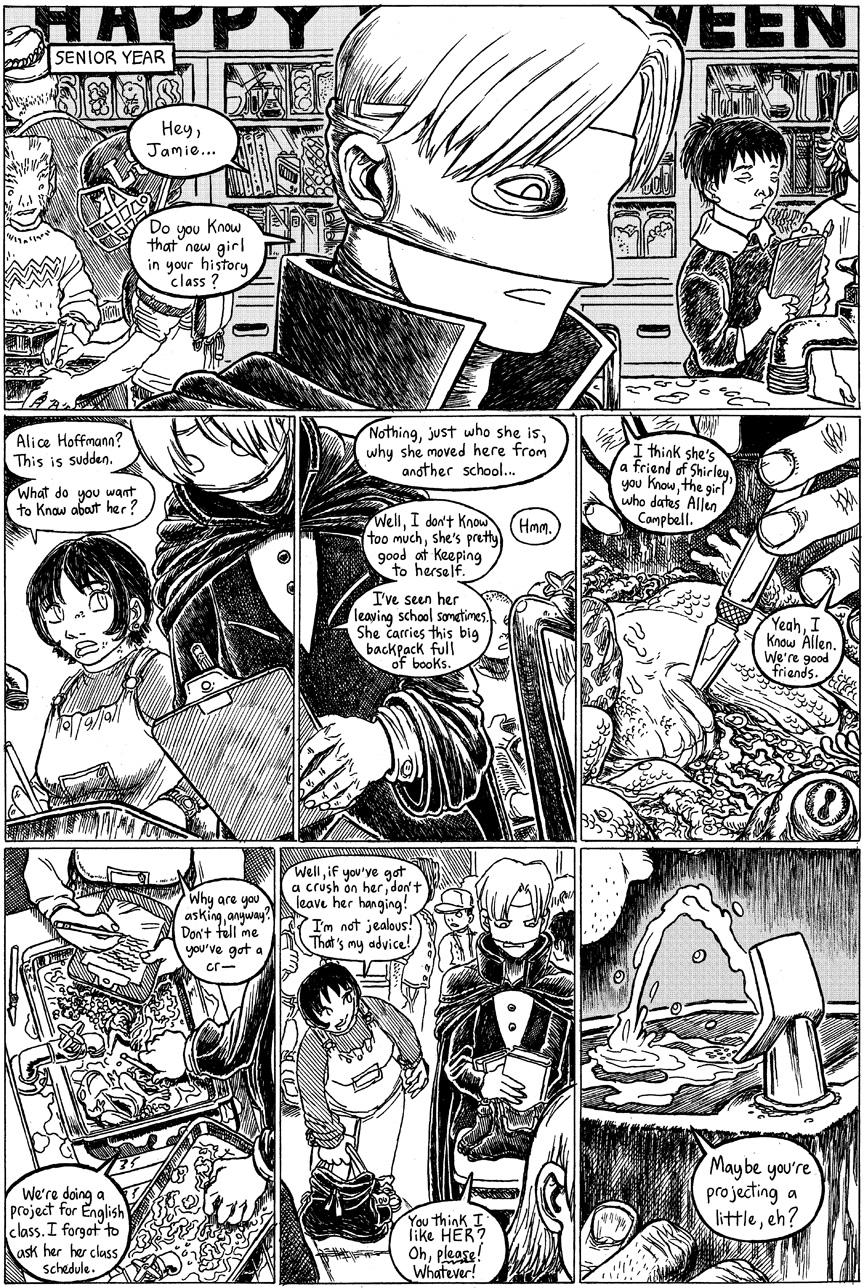The Stiff: Chapter 2: Page 38
Continuing my reposted essay on zombies from the last page….
******
THE THEMES OF ZOMBIES, PART 2: INFECTION (and cannibalism)
“Infection” is the other main element of zombie horror movies, one which was borrowed from vampires. Richard Matheson’s ’60s horror novel I AM LEGEND, which inspired George Romero, is basically based on the premise “If vampires really existed, wouldn’t everyone on earth be turned into a vampire almost immediately?” In zombie movies, the infection is caused by cannibalism, but in practice it’s not much different from the tidy bites of vampires and werewolves. Occasionally it doesn’t even require physical contact, as with the cell phone zombies in Stephen King’s CELL.
The point of infection is — “zombies are capable of turning other people into zombies.” I think this element is more important than “cannibalism” specifically. In THE RISING, the zombies eat bits and pieces of people, but it seems to be thrown in as an afterthought because it’s gross and that’s what readers expect zombies to do. (The Keene zombies say at one point that they eat people for energy, but their main focus is just killing people. Unlike in 28 DAYS LATER, they don’t actually starve to death if they don’t get enough to eat.) In THE BREEZE HORROR, an old paperback horror novel by the otherwise unknown writer Candace Caponegro, there is no element of zombie-to-human infection at all. At the beginning of the book, the world is apparently destroyed by nuclear waste raining from the sky, and a group of survivors gather in this place similar to Coney Island, whereupon the people who got soaked by the rain gradually turn into pus-dripping, zombie-like undead monsters. However, the undead don’t have the power to turn the living into zombies… once the rain stops, the zombie train has left the station… so the rest of the book consists of the zombies (who still have most of their former personalities) and the humans trying and failing to live together without killing one another. It could be titled “My Neighbors the Zombies.” While the idea of zombies motivated by rage, regret and envy towards the living is promising (in fact, it’s strangely similar to the motivations of classical undead and ghosts), the lack of “infection” makes it very different from a Romero-type zombie movie. The book is basically pulp; on the upside it’s got a nice feeling of illogical, surprising horror and futility (if that doesn’t sound like the “upside,” well, sorry); on the downside, some of the characterizations are incredibly stupid, including some racial stereotypes (the one black character talks in a “Mammy” accent, albeit only for the three pages from her first appearance until her death, as if that makes it any better).
NEXT UPDATE: Monday! Including more zombies!

I wonder if the modern zombie “infection” theme was influenced by John W. Campbell’s 1938 novella “Who Goes There?” (which was filmed three times). In the story, physical contact is all that’s needed for the alien organism (which can perfectly mimic any living thing) to infect you and turn you into an alien capable of infecting others, etc. It’s very hard to imagine an effective defense against an intelligent disease!
Though the misnamed “zombies” are closer to ghouls, the original ones were supposed to be the enslaved dead and there was no talk of infection or cannibalism. However there was cannibalism in the original Re-Animator stories of H. P. Lovecraft that wasn’t used in any of the movies. (Though blood was infused by the head of the doctor in the first one.)
I wondered what would happen if a further mutation of the Z infection was those that started to retain their intelligence and personalities. Some movies have done so, two on SyFy in the past several years.
I have seen only two of the three versions of Matheson’s “I Am Legion.” I have been disappointed twice that the last logical step in the novel was not used. I guess they though it was too much of a downer.